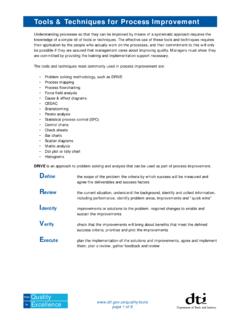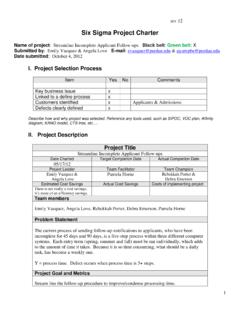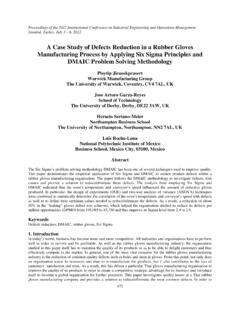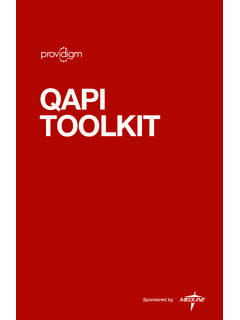Transcription of Principles and Tools of Total Quality Management
1 UNESCO EOLSSSAMPLE CHAPTERSSYSTEMS ENGINEERING AND Management FOR SUSTAINABLE DEVELOPMENT - Vol. II - Principles and Tools of Total Quality Management - Melsa, J. L. Encyclopedia of Life Support Systems (EOLSS) Principles AND Tools OF Total Quality Management Melsa, J. L. College of Engineering, Iowa State University, USA Keywords: Quality , Quality Management , Benchmarking Contents 1. Introduction 2. Total Quality Management Tools 3. Total Quality Management Philosophies Visionary Leadership Customer Driven Excellence Agility Organizational and Personal Learning Management by Fact Valuing Employees and Partners Focus on the Future Managing for Innovation Social Responsibility Focus on Results and Creating Value Systems Perspective Glossary Bibliography Biographical Sketch Summary Quality improvement and cycle time reduction are no longer fads or slogans but have become the survival issues of the 21st century.
2 Companies that have adopted Quality Management practices have experienced an overall improvement in corporate performance including better employee relations, higher productivity, greater customer satisfaction, increased market share, and improved profitability. While each company developed its practices in a unique environment with its own opportunities and problems, there were common features in their Quality Management systems. These features included corporate focus on meeting customer needs, Management that led the way, the empowerment of employees to seek continuous process improvement, a flexible and responsive corporate culture, fact-based decision making, and partnerships with suppliers. It is important to note that many different kinds of companies benefited from putting specific TQM practices in place; however, none of these companies reaped those benefits immediately.
3 Allowing sufficient time for results to be achieved was as important as initiating a Quality Management program. Often when people talk about how they truly embraced the TQM strategy, they talk about a compelling event. This is often driven by a crisis such as the massive lost of business to major competitors or a significant drop in profitability. Companies such as UNESCO EOLSSSAMPLE CHAPTERSSYSTEMS ENGINEERING AND Management FOR SUSTAINABLE DEVELOPMENT - Vol. II - Principles and Tools of Total Quality Management - Melsa, J. L. Encyclopedia of Life Support Systems (EOLSS) Motorola and Xerox adopted the TQM journey after experiencing sharp competition from several Japanese companies. The big-three automakers in the United States began to embrace TQM after they had lost significant market share to Honda and Toyota.
4 Others have embraced the TQM philosophy based on a motivating vision. For example, Disney has used the vision: "The Happiest Place on the Earth," to motivate employees to new heights of customer satisfaction. While a crisis creates stress, a motivating vision creates opportunity or romance. In either case, the most important issue for success is to have a resolve to make things be different. In summary, there is no magic formula to success in the Quality journey. The work needed to implement TQM may, in many cases, seem unnatural in the sense that it is very different than anything that one has been led to believe is true. One will have to begin doing some new things, and, perhaps even more importantly, stop doing some old things. It is clear that one must allow sufficient time for results to be achieved.
5 Don't expect instantaneous results, although there is always some low-hanging fruit that will give positive reinforcement. It is important to allow sufficient time for results to be achieved. This is a journey of unending length, but it is critical to start immediately. This article provides a summary of Total Quality Management for systems engineering and Management . 1. Introduction Quality is a very misunderstood concept. To many, improved Quality means that there must be more inspection. Others believe that the only important Quality issues have to do with manufacturing operations. There has been a strongly held belief that Quality costs both time and money. Some organizations would argue that if one wants a higher Quality product, it will take longer to design and manufacture and it will cost more.
6 Interestingly, all of these beliefs have been proven to be wrong. Inspection does not improve Quality , and it turns out that real Quality issues pervade the entire organization. Finally, many companies are now demonstrating that high- Quality products can be produced more rapidly and at a lower cost. A study of the Profit Impact of Market Strategies (PIMS) Data Base [The PIMS Letter on Business Strategy, 1986], which contains financial and strategic information for around 3000 businesses over a twenty year period, indicates that in the long run, the most important single factor affecting a business unit's performance is the Quality of its products and services relative to those of its competitors. The study goes on to point out that: Businesses that offer premium Quality products and services usually have large market shares and are early entrants into their markets.
7 The clear conclusion is that Quality does not cost time! Quality is positively and significantly related to a higher return on investment for almost all kinds of products and market situations. Companies with superior relative Quality receive almost three times the return on investment (ROI) as compared with those companies with inferior relative Quality (7% vs. 20%). UNESCO EOLSSSAMPLE CHAPTERSSYSTEMS ENGINEERING AND Management FOR SUSTAINABLE DEVELOPMENT - Vol. II - Principles and Tools of Total Quality Management - Melsa, J. L. Encyclopedia of Life Support Systems (EOLSS) Product Quality is an important determinant of business profitability. High Quality producers can usually charge premium prices for their products. As we will see later, by using the right processes, Quality products can, in fact, be made at a lower cost.
8 As a result, it is clear that Quality does not cost money! A 2002 study done by the National Institute of Standards and Technology (NIST) [NIST, 2002], the governmental agency responsible for the Malcolm Baldrige National Quality Award (MBNQA) award program, shows that Quality Management can result in impressive financial returns. NIST invested a hypothetical sum of money in the Standard & Poor s (S&P) 500 and in each of the publicly traded companies (two whole companies and 18 parent companies of subsidiaries) who have won the MBNQA since 1991. The investment was tracked from the first business day in April of the year the Baldrige winner received the award, or the date they began publicly trading, through to December 3, 2001. As a group, the companies outperformed the S&P 500 by greater than 3 to 1.
9 NIST also reports [NIST 2003] that Baldrige winners exhibit such attributes as higher growth rates, better customers and employee satisfaction, and increased market share and repeat business. Total Quality Management involves both quantitative methods and human resources. Total Quality Management integrates fundamental Management techniques, existing improvement efforts, and technical Tools . It is important to understand this duality of Tools (quantitative and decision-making methods) and philosophy (people issues). Doing one without the other will not be successful. The integration of Tools and techniques is critical if TQM is to be something other than an overlay program. The next two sections of this article elaborate on these two interrelated concepts Tools and philosophy.
10 2. Total Quality Management Tools There are a wide range of TQM Tools ; the size of this article does not permit a detailed discussion of them along with appropriate examples. The following is a list of widely used Tools . There is no tool that is best for every application; the knowledgeable practitioner is aware of a rich variety of Tools and uses the appropriate one(s). Process maps: One of the important keys to understanding how to improve a process is to map the process. While there are several different approaches to process mapping, the key is to determine who does what at each step of the process. Often, the simple drawing of a process map is sufficient to solve many Quality problems because the map makes it so obvious where defects can be introduced. Poke-A-Yoke : This concept of the Japanese Management philosophy is to make a process foolproof.













